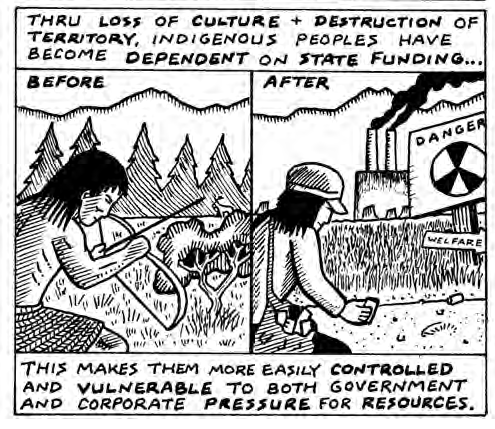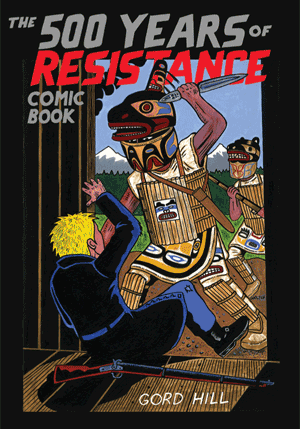Other events depicted include the 1680 Pueblo Revolt in New Mexico; the Inca insurgency in Peru from the 1500s to the 1780s; Pontiac and the 1763 Rebellion and Royal Proclamation; Geronimo and the 1860s Seminole Wars; Crazy Horse and the 1877 War on the Plains; the rise of the American Indian Movement in the 1960s; 1973's Wounded Knee; the Mohawk Oka Crisis in Quebec in 1990; and the 1995 Aazhoodena/Stoney Point resistance.
With strong, plain language and evocative illustrations, The 500 Years of Resistance Comic Book documents the fighting spirit and ongoing resistance of Indigenous peoples through five hundred years of genocide, massacres, torture, rape, displacement, and assimilation: a necessary antidote to the conventional history of the Americas. Includes an introduction by activist Ward Churchill, leader of the American Indian Movement in Colorado and a prolific writer on Indigenous resistance issues.
Gord Hill, a member of the Kwakwaka'wakw Nation in British Columbia, has been active in Indigenous resistance, anti-colonial, and anti-capitalist movements since 1990. He is also author of The 500 Years of Resistance, a pamphlet published by PM Press.
From Booklist
This slender black-and-white work is intended to inspire indigenous Americans by presenting historical evidence of their resistance to European invaders, colonizers, and “treaties.” From the fifteenth-century Taino reception of the Spanish in the Caribbean through the 1995 Ipperwash stand-down in Stoney Point, Ontario, Hill visits about a dozen events—almost all in North America—and describes in text and image how Native Peoples fought against white settlers, soldiers, and police in settlements, on open land, and even—shown here to a much lesser degree—through strikes and office raids. Hill doesn’t dig deep into any single event, and like the flat, heavily inked panels, his journalistic style tends toward minimalism in background as well as analysis. This book is a good starting point for exploring events of warrior resistance by peoples who are too often presented as weak and passive, and Ward Churchill’s introduction includes a lengthy bibliography to steer dedicated readers. In addition, teens will find this readily accessible, although the simplification of events is more inspirational than suitable for supplementing a history curriculum. --Francisca Goldsmith

Rob's review
My reaction is closer to the Booklist review than to the official blurb. In fact, I'd say Booklist understates the book's problems.
Let's start with Ward Churchill's introduction. It goes on for fourteen pages plus five pages of footnotes. Most of those pages are Churchill talking about his own adventures. Only in the last couple of pages does he mention Gord Hill's book.
Churchill claims he had to talk about his own resistance before he could talk about the book's. One could summarize his message in three words: Remember the past. Everything else in the intro is puffery designed to show how significant Churchill and his antics are.
The concept of 500 Years of Resistance is a good one. By focusing only on acts of resistance, it shows how Native took charge of their own fates. They didn't wait around for disease and warfare to conquer them; they fought back.
But the list of events covered in second paragraph (above) is misleading. Hill devotes only two pages to "The War on the Plains," which most people would say was the climax of the Indian Wars. He follows that with eight pages of "The War on the Coast"--British and other European attacks in the Pacific Northwest.
Most of the incidents are minor: a skirmish or raid here, a bit of gun or cannon fire there. Hill obviously wants to include his British Columbian history, but he doesn't make a case for spending so much space on it. The section skews the whole work; it makes you wonder about Hill's agenda.
Modern section skewed too
The same is true of the rest of the book, which covers the following subjects with the given number of pages:
Alcatraz and the Trail of Broken Treaties: 6
Wounded Knee '73: 2
Oka Crisis: 4
Zapatistas: 3
Standoff at Ts'Peten: 6
Aazhoodena: 4
I hadn't heard about Ts'Peten and don't know anything about Aazhoodena, so I question the space devoted to them. Again, Hill doesn't make a case for the significance of these events. It's clear he wanted to highlight lesser-known events in Canada, but again, it skews the book's coverage.
That's ten of 25 pages, or 40%, on recent events that few have heard of. Meanwhile, there's nothing about the tobacco battles in upstate New York, the Navajo battles against coal mining in Arizona, the Dann sisters' land battles in Nevada, or the gaming battles throughout the US. Each of these deserves one or two pages in a book about Native resistance.
Hill might've been better off focusing his book on the resistance in Canada, because that's where his heart seems to lie. Really, the book's title could be 500 Years of Resistance That's Important to Me or something like that. Few would say he included all the highlights of Native history in an evenhanded manner. Unfortunately, that makes the book less useful than it could be to the uninitiated.


No comments:
Post a Comment
Note: Only a member of this blog may post a comment.